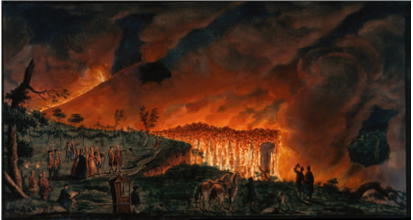Geologist and science writer Nina Morgan discusses a hot topic
With explosive eruptions taking place in Hawaii and Guatemala, volcanoes are all in the news these days. Back in the 18th and early 19th centuries, the pioneering volcanologist, Sir William Hamilton [1730–1803] was in the news too—but for all the wrong reasons.

Image above: Coloured etching by Pietro Fabris, 1776, of lava emerging from Mount Vesuvius (Credit: Wellcome Collection, CC-BY)
Hamilton, son of Lord Archibald Hamilton, a lord commissioner of the Admiralty, and Lady Jane Hamilton, a mistress of the robes to the Princess of Wales, arrived in Naples as the British envoy to the Neapolitan royal court in 1764. Soon after his arrival, Vesuvius went into an eruptive phase, and Hamilton became hooked. By 1778 he was an 'addict', confessing in a letter to his nephew, Greville, "I am mad on the subject of volcanoes".
During the Vesuvius eruptions of 1767, 1779 and 1794, Hamilton made more than 65 ascents of the crater to observe and record the volcanic activity. He also studied Mount Etna on Sicily and shipped a large number of volcanic rock, ash and lava specimens to London. He was elected a Fellow of the Royal Society in 1766, and his observations and drawings of the volcanic activity were published in the Philosophical Transactions between 1767 and 1795, earning him the nicknames 'the modern Pliny' and the 'professor of earthquakes'. He was awarded the Copley medal by the Royal Society in 1770 for one of his papers on volcanology.
Picture book
After publishing a book of Observations on Vesuvius in 1772, which included five illustrative plates and a map, Hamilton went on to create a definitive guide to Vesuvius, a book he hoped "may perhaps render every other account of the late Eruption superfluous". The main text consisted of Hamilton's letters to the Royal Society, both in English and his own French translation. But it is the pictures rather than the words that proved to be the real highlight of the book. These included the 54 hand-coloured illustrations based on sketches made, in situ, by the Anglo-Neapolitan artist Pietro [Peter] Fabris, and individually coloured by local artists, under Hamilton's personal supervision.
This great work was published in 1776 under the title Campi phlegraei: Observations on the Volcanoes of the Two Sicilies. The book's title refers to the area around Naples known as 'flaming fields'. Complete copies of the book are rare today, because the gouache-coloured plates proved so popular that they were often torn out and displayed as souvenirs in their own right.
Popular imagination
In spite of his pioneering studies on volcanism, Hamilton is probably best known in popular imagination as the cuckolded husband of Emma, the mistress of the married naval hero, Captain Horatio Nelson [1758–1805]. After Hamilton's first wife, Catherine, whom he described as 'an amiable and true friend' died in 1782 in Naples, Hamilton, in his grief, requested leave to return to London for a time. There he met Emma Lyon, then mistress of Hamilton's nephew, Greville. Hamilton was smitten, and Greville, wanting to replace Emma with a wealthy wife, encouraged the attraction. One thing led to another and Hamilton and Emma were married in London 1791. Emma's notorious loose morals created havoc with Hamilton's reputation, and her first encounters with Nelson in 1793 marked the end of Hamilton's diplomatic career. By 1800 Emma was already pregnant with Nelson's child, and both Nelson and the Hamiltons returned to London. There Nelson abandoned his wife and went to live in a ménage a trois with the couple in a rented house in Piccadilly. The resulting scandal hit the headlines and the trio were ostracized by the court and polite society. Hamilton died in London in 1803, with Emma and Nelson at his side.
How Hamilton really felt about the loss of his diplomatic career and the scandalous publicity that ensued is hard to assess. But when it came to volcanoes, he was clearly keen to put himself into the picture. In a number of Fabris's illustrations for Campi phlegraei Hamilton appears prominently, dressed in a red coat.
Sources for this vignette include the DNB entries for Sir William Hamilton by Geoffrey V. Morson and for Lady Emma Hamilton by Tom Pocock; Aesthetic geology—Sir William Hamilton’s ‘Campi Phlegraei’, which appeared on Dr Ralph Harrington's Volcanism Blog, posted on 14 June 2008 at https://volcanism.wordpress.com/2008/06/14/aesthetic-geology-sir-william-hamiltons-campi-phlegraei/; and the Glasgow University Library Special Collections Department Book of the Month for October 2007, available at http://special.lib.gla.ac.uk/exhibns/month/oct2007.html.
Nina Morgan is a geologist and science writer based near Oxford. Her latest book, The Geology of Oxford Gravestones, is available via www.gravestonegeology.uk.